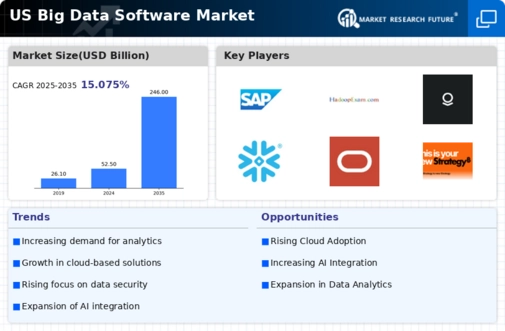Rising Demand for Real-Time Analytics
The big data-software market is experiencing a notable surge in demand for real-time analytics solutions. Organizations are increasingly recognizing the value of immediate insights derived from data, which can enhance decision-making processes. According to recent estimates, the market for real-time analytics is projected to grow at a CAGR of approximately 30% over the next five years. This growth is driven by the need for businesses to respond swiftly to market changes and customer preferences. As a result, software providers are focusing on developing tools that facilitate real-time data processing and visualization. The ability to analyze data as it is generated allows companies to optimize operations and improve customer experiences, thereby solidifying the importance of real-time analytics in the big data-software market.
Expansion of Data-Driven Decision Making
The big data-software market is significantly influenced by the ongoing expansion of data-driven decision-making practices across various industries. Organizations are increasingly leveraging data analytics to inform strategic choices, leading to improved operational efficiency and competitive advantage. A report indicates that companies utilizing data-driven strategies are 5 times more likely to make faster decisions than their competitors. This trend is prompting software developers to create more sophisticated analytics tools that cater to the needs of businesses seeking to harness the power of data. As the emphasis on data-driven insights continues to grow, the big data-software market is likely to see an influx of innovative solutions designed to support this paradigm shift.
Growing Importance of Predictive Analytics
The growing importance of predictive analytics is a significant driver in the big data-software market. Organizations are increasingly adopting predictive models to forecast trends and behaviors, which can lead to more informed strategic planning. Research indicates that the predictive analytics market is expected to reach $20 billion by 2027, highlighting its critical role in business intelligence. This trend is prompting software vendors to enhance their offerings with advanced predictive capabilities, allowing users to leverage historical data for future insights. As businesses recognize the potential of predictive analytics to drive growth and efficiency, the demand for sophisticated big data software solutions is likely to escalate.
Increased Investment in Data Infrastructure
Investment in data infrastructure is a critical driver for the big data-software market. Organizations are allocating substantial resources to enhance their data storage, processing, and management capabilities. Recent data suggests that spending on data infrastructure in the US is expected to reach $50 billion by 2026, reflecting a robust commitment to building scalable and efficient systems. This investment is essential for supporting the growing volumes of data generated by businesses and ensuring that they can effectively utilize this data for analytics. As companies prioritize the establishment of strong data foundations, the demand for advanced big data software solutions is likely to rise, further propelling market growth.
Emergence of Advanced Data Visualization Tools
The emergence of advanced data visualization tools is reshaping the big data-software market. As organizations grapple with increasingly complex datasets, the need for intuitive visualization solutions has become paramount. These tools enable users to interpret data more effectively, facilitating better insights and decision-making. The market for data visualization software is projected to grow at a CAGR of around 25% over the next few years. This growth is indicative of the rising importance of visual analytics in helping businesses comprehend large volumes of data. Consequently, software developers are focusing on creating innovative visualization tools that cater to diverse user needs, thereby enhancing the overall value proposition of the big data-software market.

























Leave a Comment